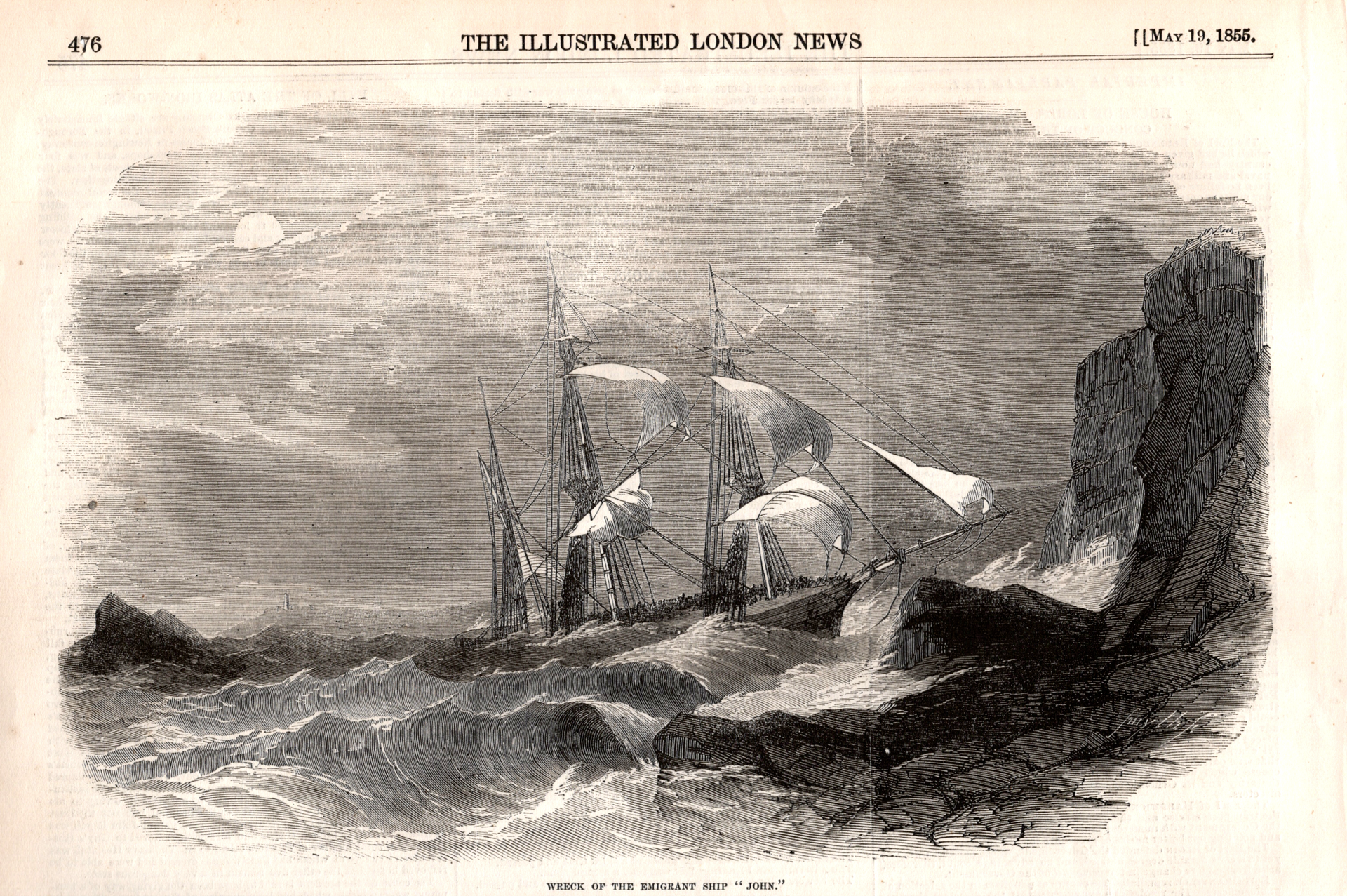Wreck of the "John" 3 May 1855
The middle of the nineteenth century was a popular time for emigration to the colonies, particularly Australia, New Zealand, Canada and South Africa. Canada traditionally had been a popular destination for the inhabitants of Plymouth and North Devon who were mainly driven by the prospect of a better life. In May 1855 the barque “John” set sail from Plymouth for Quebec with about 270 passengers, mainly from Devon and Cornwall. Several of these were from mid Devon. The ship took a course too close to the shore and ran aground just a few hours later on the Manacles Rocks, just off the coast at St Keverne in Cornwall. About 194 passengers died, mostly women and young children. All 19 crew survived.
Extensive research on the “John” Disaster has been done by Mark Sandford
The adult fare was four pounds. Immediately after the disaster, survivors were offered a refund of one pound. Many had lost all their possessions.

It is not clear how much compensation the relatives received.
Passengers on the "John" from mid Devon
William and Eliza Hallett
William Hallett, then aged 29, married Eliza Gould (22) in Spreyton Church on 26 April 1855. Both came from farming families, Eliza’s widowed mother farmed at Spreyton Wood. Just a week later the couple set off for their new life in Quebec on board the “John”. Eliza drowned. Her body was the only one formally identified and it was her death that was singled out for the manslaughter charge later brought against the captain Edward Rawle.
Coroner’s Inquest, Red Lion Inn, St Keverne. 5 May 1855 Royal Cornwall Gazette Supplement - Friday 11 May 1855
The only body identified was that of Eliza Hallett, aged 22 years; and the first witness sworn was her husband William Hallett, farmer, of Spreyton, in Devon. He deposed:- “I identify the body of deceased to be my wife; I was a passenger with her on board the John, emigrant barque Captain Rawle, which sailed from Plymouth for Quebec last Thursday afternoon, about 4 o'clock. My wife was drowned between two and three o'clock the following morning, near the Manacles Rocks. We were both washed off the fore-deck together, and caught hold of a rope, part of the rigging; but she was obliged to let go her hold, and I did not see her again until I saw her body in the church to-day. The vessel first struck at about half past 10 on Thursday evening. I was in bed at the time, but went on deck as soon as I could dress myself. On getting there I asked the captain if there was any danger; he said "no! we should all be saved against the morning." The night was darkish, but I could see the hills ashore. After a time, I took to the rigging, where I remained till about 6 o'clock, when I was taken off in a boat… The passengers kept on begging the sailors to get the boats out; but the sailors swore upon the passengers and asked them what they were afraid of; and said there was no danger. I dont know whether the sailors were drunk or sober... The sea was comparatively smooth for some time after I got upon deck, and if proper exertions had been made there was time to land all the passengers.”
William Hallett returned to his parents’ farm at Aylesbury. In October 1856 he married Eliza Parsons in nearby Harpford. They moved to Guernsey in 1861, where he was employed as a gardener. They had 10 children. He died in Guernsey in 1899.
Philip and Mary Gibbings and their three sons, Thomas, Samuel and George.
Philip Gibbings was a farm worker born in Coldridge in 1817. In 1846, he married Mary Cooke (b 1826) in Zeal Monachorum. They lived at Fishers near Loosebeare in Zeal and had three sons before preparing to emigrate to Canada. The whole family perished when the John ran aground.
Henry and Maria Jeffrey and their children Mary Ann and William Henry.
Henry was the illegitimate son of Ann Jeffrey of Zeal Monachorum where he was born in 1829. In 1850, he was married in Tavistock to Maria Hooper aged 22, also from Zeal. At that time he was working as a tanner. The following year they moved to near Calstock in Cornwall. They had two children aged 4 and 2 when they set off for Quebec. Maria and the children drowned in the disaster; it is believed Henry survived with an injured leg. He emigrated to Ontario, Canada where he married Elizabeth Hooper in 1860. His half-brother Ephrain Jeffery, born in Zeal Monachorum in 1847, joined him in 1871. Henry died in Canada in 1890.
Dinah and Eliza Mortimore
These two sisters were passengers on the fateful voyage. Born in Witheridge, both were house servants before they left for Canada, Dinah in Morchard Bishop, Eliza in her home town. Both drowned, aged 24 and 20 respectively. They were likely heading to join their parents and siblings in Ridgeway, New York State.
At a subsequent trial, Edward Rawle, captain of the "John", was found "not guilty" of manslaughter. It would seem that he had been, to say the least, careless in allowing his ship to run aground. The life boats were not seaworthy. That all the crew survived may partially have been due to the fact that they were fit young men. Needless to say there was a great deal of criticism of Captain Rawle, who continued his career as a mariner.
